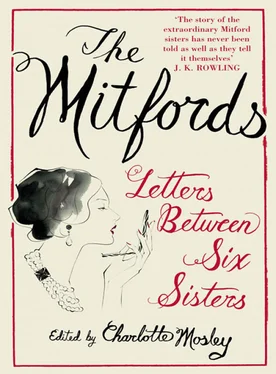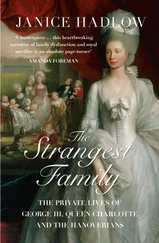The sisters were in awe of their father. Strikingly handsome, with the brilliant blue eyes that passed down to his children, he was kind-hearted, jovial and the source of much of the fun that was had in the family. Deborah remembered him as ‘charming, brilliant without being clever’ and uproariously funny when in a good mood. She wrote that when he and Nancy started sparring they were better than anything she had ever seen on stage, ‘a pair of comedians of the first order’. But he could also be impatient and had a violent temper. The smallest transgression – a child spilling her food or being a minute late – could send him into a towering rage. His anger was all the more alarming for being unpredictable: he would turn with sudden fury on one of his daughters and then, for no apparent reason, decide to single out another. Their way of standing up to him, and of drawing his unwrathful attention, was to catch their father in one of his sunnier moods and tease him, which he took in good part. Jessica used to call him ‘the Old Sub-Human’ and pretend to measure his skull for science or would gently shake his hand when he was drinking a cup of tea to give him ‘palsy practice’ for when he grew old. Nancy’s caricature of him in her first novel, Highland Fling, as the jingoistic, hot-tempered General Murgatroyd – a precursor of the formidable Uncle Matthew in her later novels – was an effective way of reducing this larger-than-life figure to less alarming dimensions. As they grew up, the sisters rarely seem to have resented Farve and looked back on his autocratic eccentricities with affectionate amusement. The inclination to hero – worship is foreshadowed in their relationship with their father; like the other powerful men who were to come into their lives, he could do no wrong.
Their resentment – and that of Nancy and Jessica in particular – against the perceived shortcomings of their upbringing was reserved for their mother. In contrast to her moody, volatile husband, Sydney, or ‘Muv’ as her children called her, was cool and detached. Her own mother had died when she was seven years old and at the age of fourteen she had taken on the responsibility of running her father’s household. This had taught her financial prudence and to be a good manager – qualities that came in useful later when raising a family of seven on never quite enough money – but it also created a certain rigidity in her attitude to her children when they were growing up; an inflexibility that fuelled her daughters’ rebellious behaviour and their desire to shock.
From her father, Lady Redesdale had inherited definite opinions about health and diet, believing that the ‘good body’ would heal itself more effectively without the intervention of doctors or medicine. An early campaigner against refined sugar and white flour, she made sure that her children ate only wholemeal bread, baked to her recipe. Physically undemonstrative, she rarely exhibited outward signs of maternal warmth and seldom hugged or cuddled her daughters, who had to compete fiercely for the scarce resource of her attention. In ‘Blor’, an essay on her childhood, Nancy described her mother as living ‘in a dream world of her own’, detached to the point of neglect. In her fictional portrait of her as Aunt Sadie, she depicted a more sympathetic character but one that was nevertheless remote and disapproving. But the aloofness that some of her daughters complained of also had its positive side, enabling their mother to remain calm in the face of an unpredictable husband and to deal impartially with six boisterous and constantly feuding girls (her ambition had been to have seven boys). She was also fair, principled, direct, selfless and honest to the point of innocence. As the sisters grew up and their escapades sent their mother reeling from one calamity to the next, her unshakeable loyalty and acceptance of their choices in life showed that she cared for her daughters very much indeed.
Like most girls of their class and generation, the sisters were educated at home. Lady Redesdale taught all her children until they were eight, after which the girls moved to the schoolroom to be instructed by governesses and Tom was sent away to boarding school. Nancy and Jessica blamed their mother for this lack of formal education, even though Lord Redesdale was just as opposed to sending his daughters to school. ‘Nothing would have induced him to waste money on anything so frivolous’, wrote Deborah. He also worried that they might develop thick calves from being made to play hockey. Neither parent believed that girls should be educated beyond basic literacy and regarded intellectual women as ‘rather dreadful’. The Redesdales’ views were not uncommon at the time but their children’s response was more unusual. Nancy’s bitterness at not having received what she considered a proper education was enduring and runs as a refrain throughout her correspondence. Jessica wrote that the dream of her childhood was to be allowed to go to school, and that her mother’s refusal to countenance it had burned into her soul.
It is questionable, however, whether the sisters would have been better educated had they gone away to school. At the time, fashionable establishments for girls taught social rather than intellectual skills, preparing pupils for marriage and the drawing-room rather than the workplace. When the Redesdales eventually allowed Nancy, at the age of sixteen, to go to Hatherop Castle, a small private school for girls from ‘suitable’ families, the mainly non-academic curriculum concentrated on music, dancing and French, whereas at home, the sisters were free to make use of their grandfather’s first-rate library and Nancy and Diana became bookworms at an early age. It was perhaps the boredom of being confined at home with only siblings for company that rankled with Jessica and Nancy as much as their lack of formal schooling. Not until they left home and had to earn a living – they were the only two sisters who did not marry rich men – did they have cause to view their rudimentary education as a handicap.
The age gap between the Mitford children meant that they formed almost two separate generations. In 1925, the year that opens this collection of letters, the older children, Nancy, Pamela, Tom and Diana, ranged between the ages of twenty-one and fifteen. The youngest three, Unity, Jessica and Deborah, were aged eleven, eight and five. Nancy had ‘come out’ when she was eighteen and had followed her first season as a debutante with three further years of weekend parties and balls. She had met the right people, made many friends and quite enjoyed herself, but she had failed to do the expected thing and find a husband. With very little money and no immediate prospects, she was living at home, taking out her frustration on her sisters. The three youngest looked up to her like a remote star: her vitality, cleverness and supreme funniness lit up the family atmosphere, as did her determination to turn everything into a joke, but she was too caustic and indiscreet to be the recipient of anyone’s confidences. In Unity’s copy of All About Everybody, a little book of printed questions that she asked her family and friends to fill in, Nancy put as her besetting sin ‘disloyalty’, a trait that could make her incomparably good company but an uncertain ally.
Nancy’s usual victim was Pamela, whose unguarded nature made her an obvious target for teasing. Diana, however, presented more of a challenge; she was fully Nancy’s intellectual equal, with just as determined a character, and was able to stand up to her sister’s bullying. Occasionally Nancy managed to exert her seniority and successfully torment her younger sister. When she was sixteen, she formed a company of Girl Guides, appointed herself captain and tried to make ten-year-old Diana salute her. On another occasion, she pretended to have heard the Redesdales discuss sending Diana to boarding school, an idea that filled her little sister with horror. But they both enjoyed reading, which drew them together, as did a similar sense of humour and a longing to escape the confinement of Swinbrook. As they grew up, they became, according to Diana, great friends. But underlying the friendship was a deep current of envy on Nancy’s part towards a younger sister who was already a great beauty and the instant centre of attention with the undergraduate friends that Nancy brought home. These feelings were exacerbated when Diana, aged eighteen, married the extremely rich and good-looking Bryan Guinness and became a sought-after London hostess.
Читать дальше












